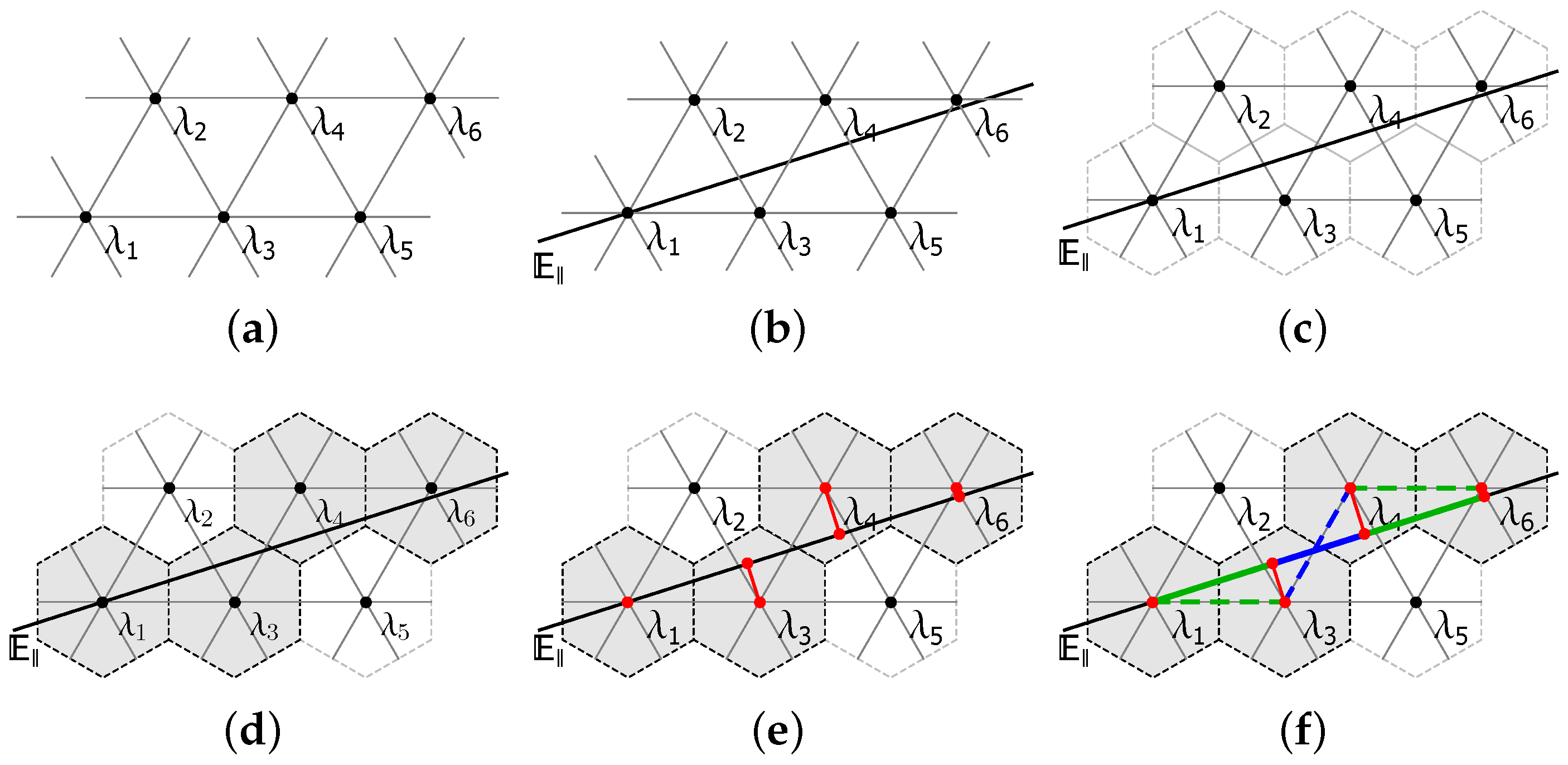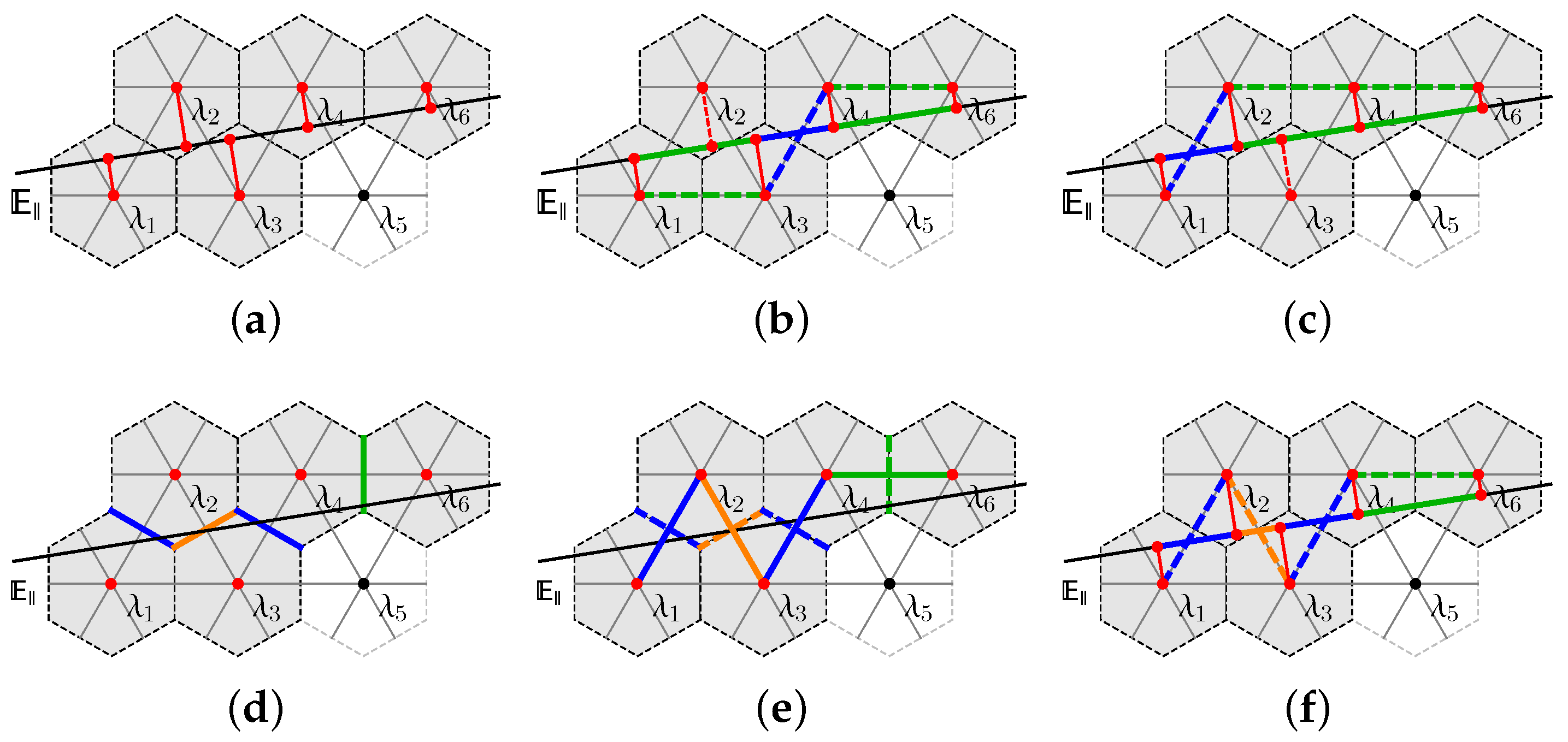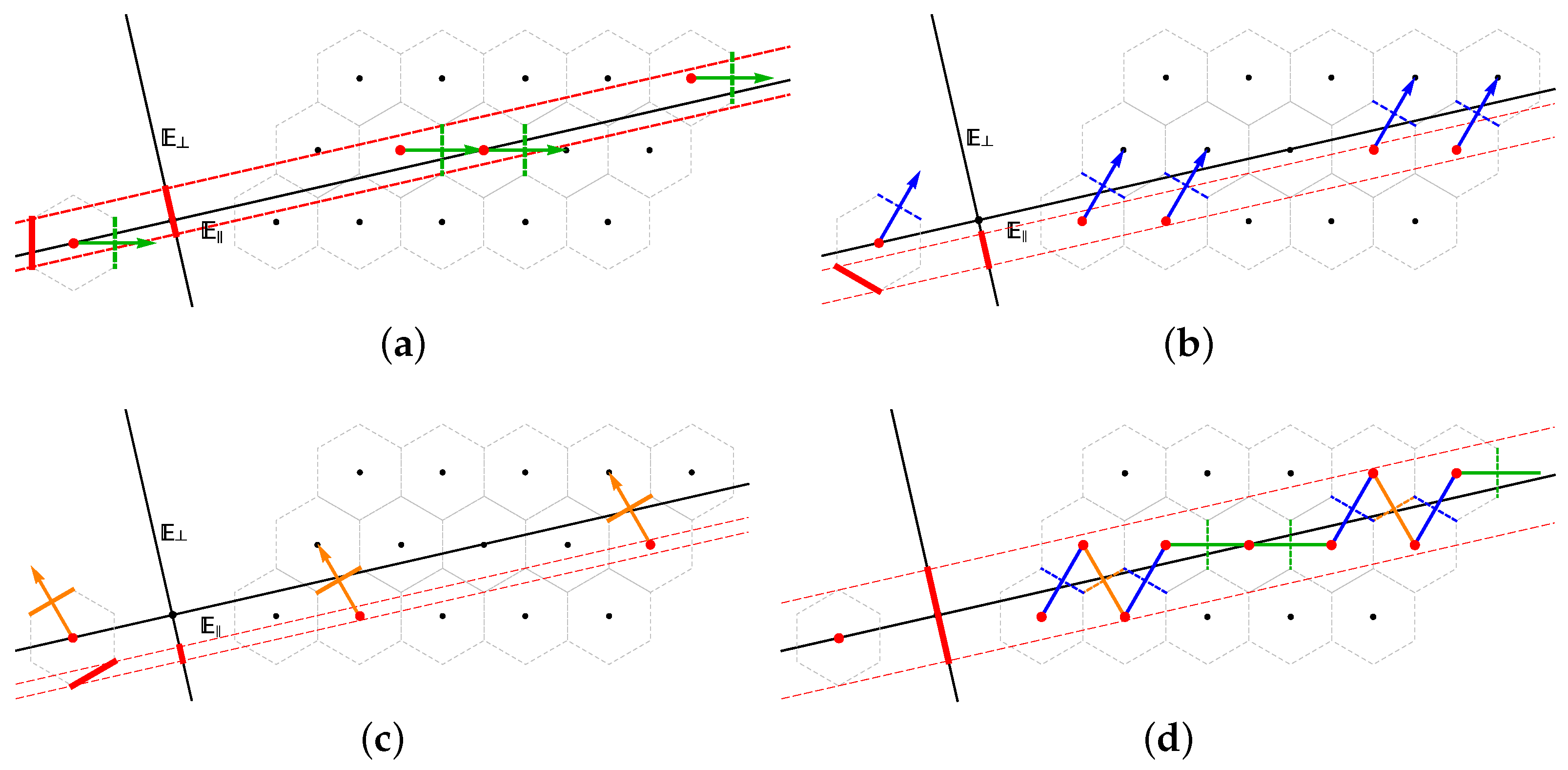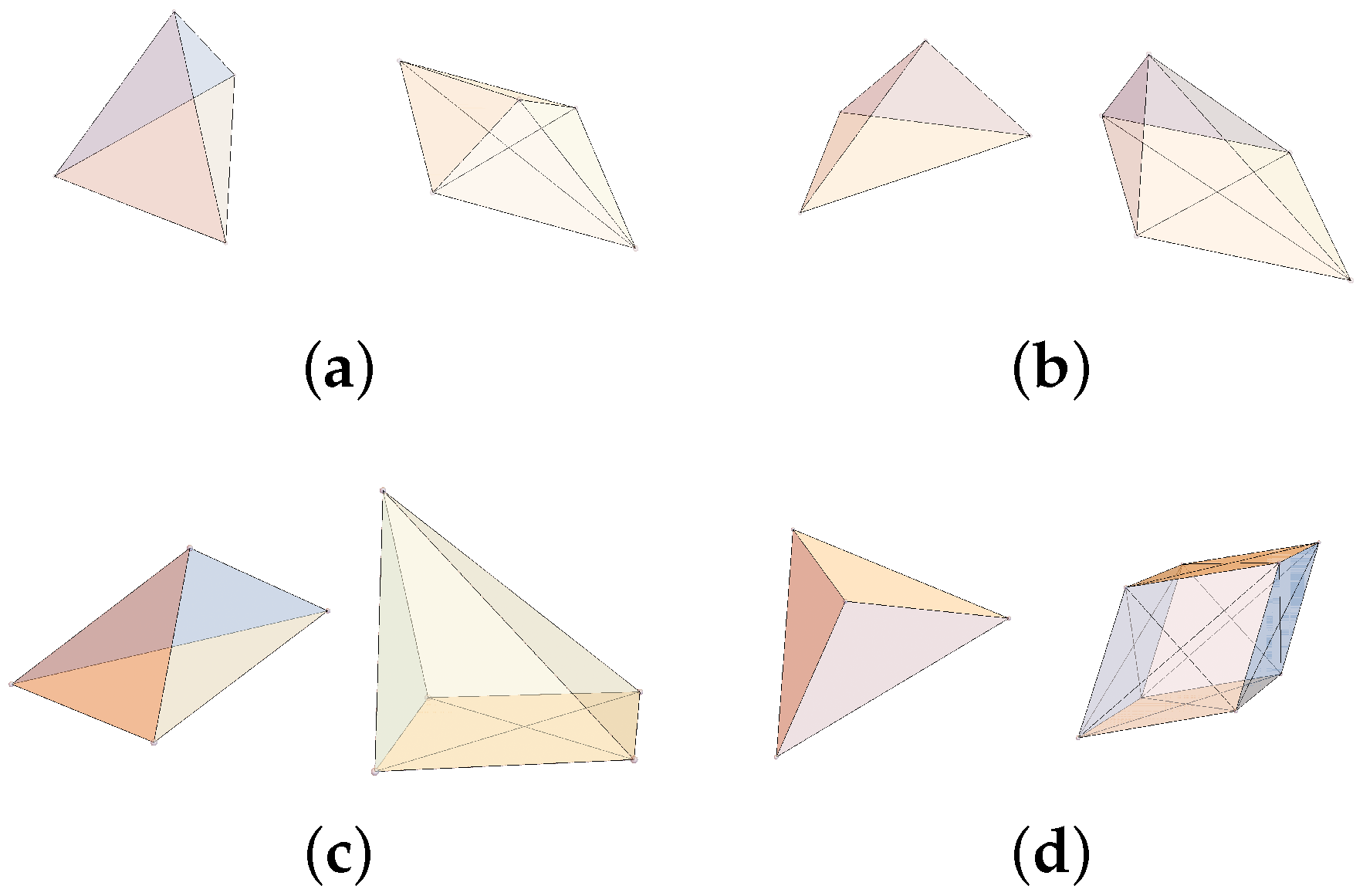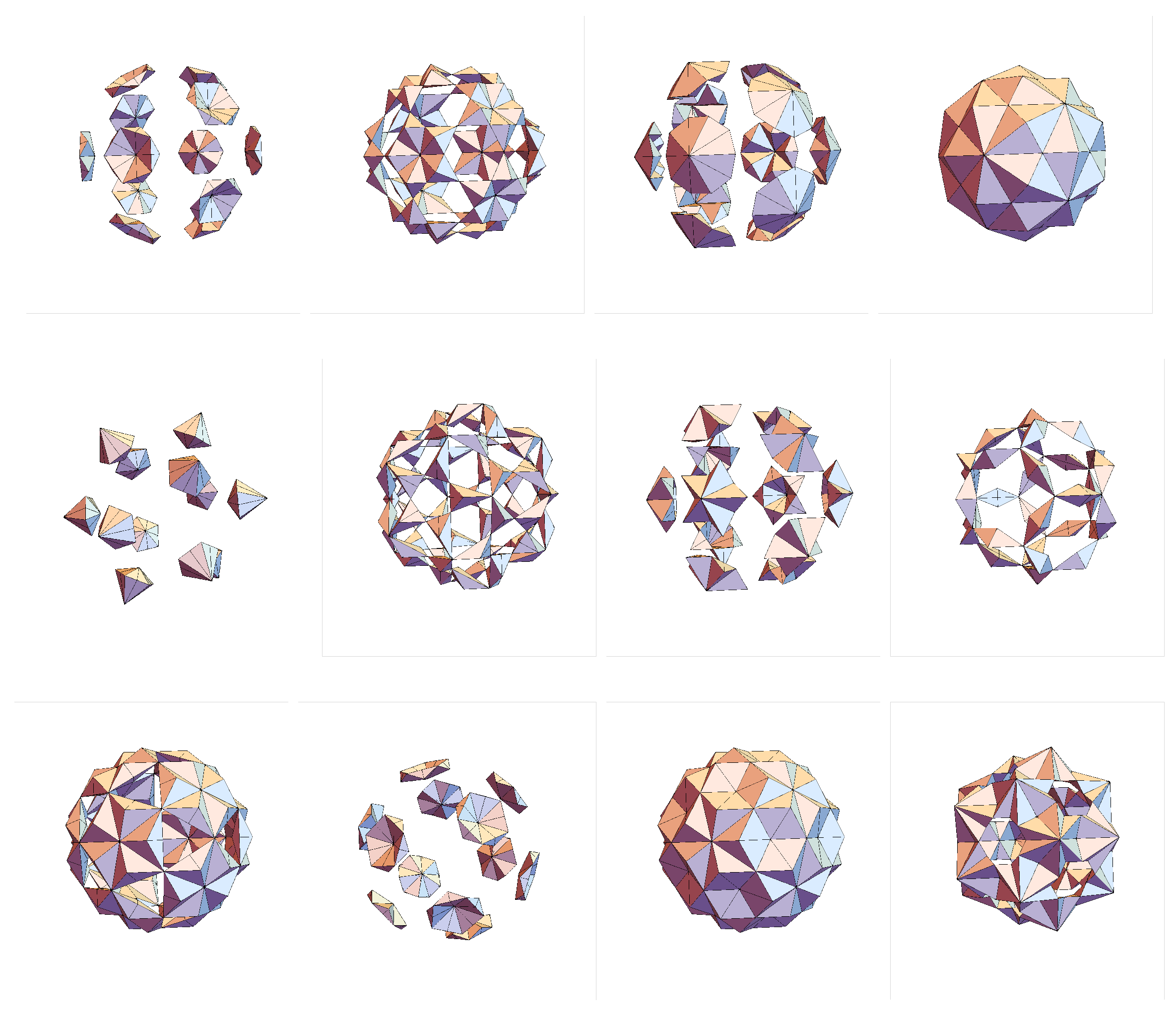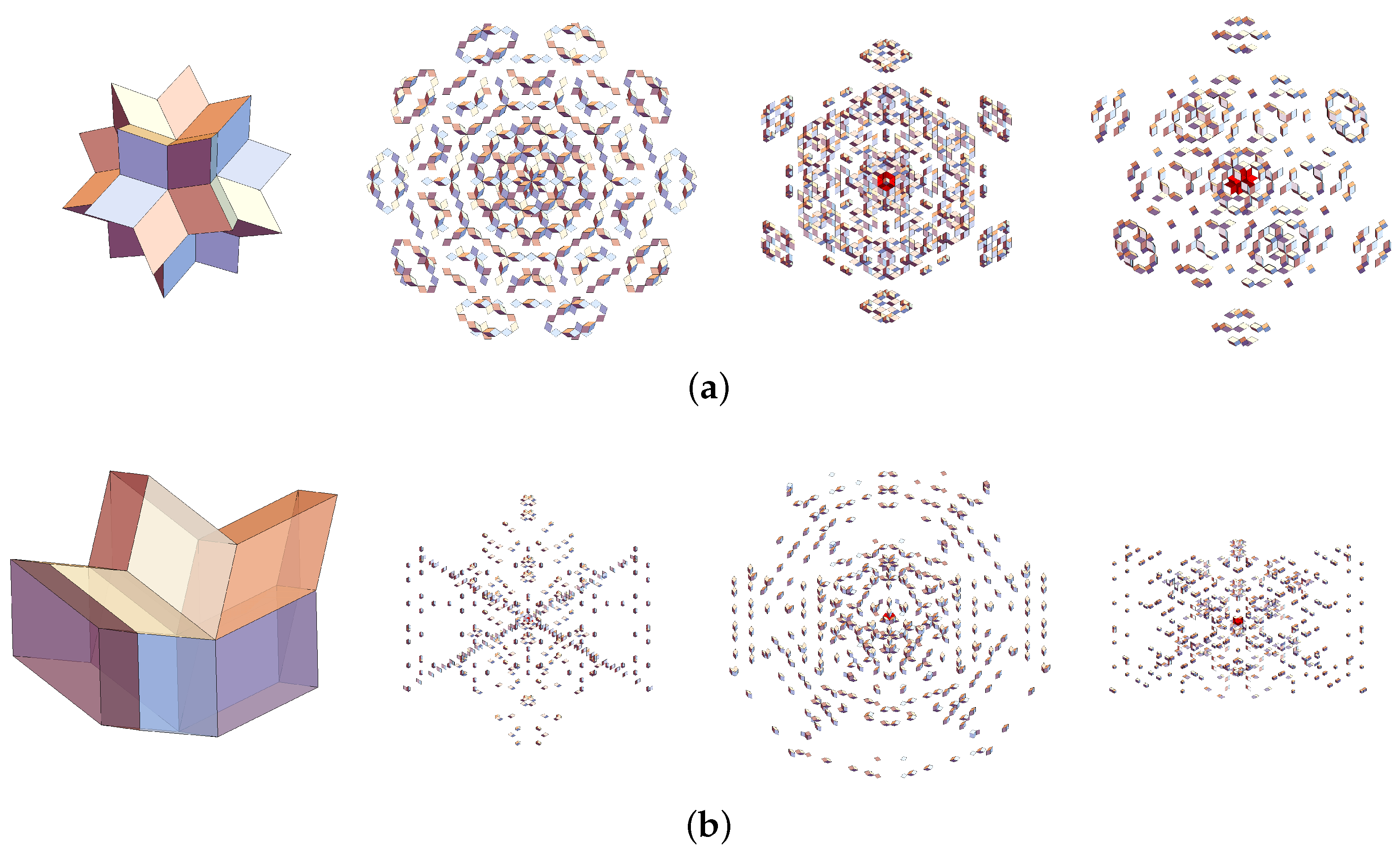2.1. Overview of Projection Method
The projection method for constructing quasicrystals is characterized by a lattice along with projections onto orthogonal subspaces . A convex volume in the perpendicular space called the cut-window acts as an acceptance domain for determining which points are selected to have their projections included in the tiling of . For cubic lattices () the cut-window is sufficient for determining which tiles fill the tiling space . But when projecting non-cubic lattices, the proper selection of tiles is more nuanced and requires that the cut-window be subdivided into regions which act as acceptance domains for individual tiles types. These regions can be further subdivided into sectors which serve as acceptance domains for specific vertex configurations; computing the relative sector volumes gives the vertex frequencies. Furthermore, similar constructions involving the regions of the cut-window can be used to compute empires in a concise and novel way.
Let
be a regular point lattice in an
N-dimensional Euclidean space,
, which is defined as the integer combinations of some finite set of lattice root vectors
:
It is assumed [
5] that the vectors
span all of
, and that the convex hull of the lattice itself is the entire space,
. Also, we assume that the lattice is a discrete point set, meaning that it has no accumulation points in
. Let
be an
n-dimensional affine subspace of
in which a space-filling tiling
will be constructed. For the purpose of creating an aperiodic tiling in
, it is necessary for
to lie at irrational angles to the vectors which generate the lattice. Let
be the orthogonal complement to
and let
and
denote the projections onto
and
, respectively.
The projection method dictates that a lattice point
will be included in the tiling
precisely when the tiling subspace
intersects non-trivially with the Voronoi cell
containing
[
5]:
where the
Voronoi cell of a lattice point
is the convex region in
defined relative to the lattice by:
See
Figure 1 for an example of the selection process defined by Equation (
2) for a quasicrystal tiling, denoted
, defined as a projection of the triangular
lattice to
. This selection criteria determines which vertices
are included in the tiling
. The next step is to understand how the selected vertices are connected by edges, faces, …, and
k-polytopes. The polytopes of
are selected from the polytopes of the Delaunay complex of the lattice. The polytopes which become the proper space-filling tiles
covering
are
n-dimensional polytopes of the lattice’s Delaunay complex which project to
n-dimensional polytopes in
. In order for such a polytope
to be included in the tiling
, it is certainly necessary that each of its vertices be included in
as well (i.e.,
). This condition is necessary, and for cubic lattices it suffices to yield an accurate selection of tiles. But when projecting from a non-cubic lattice, these criteria are insufficient and in some cases can lead to an inconsistent selection of tiles (e.g., tiles that overlap or otherwise intersect). See
Figure 2 for a scenario (in the case of a projection
) where following this rule alone leads to overlapping tiles in
.
Before giving the condition for properly selecting which edges to project to
for inclusion in the tiling
, we first take a moment to talk about the polytopes which comprise the Voronoi cells themselves. This has investigated in detail by previous authors [
5,
18], so here we provide only an overview. The Voronoi cells are convex polytopes which tessellate and fill the space
. These polytopes have boundary facets which are themselves convex polytopes (of co-dimension 1), and which themselves have boundaries (of co-dimension 2), and so on.
Let
denote the
Voronoi complex defined (relative to the lattice) as the set of all the Voronoi cells
along with all of their boundary polytopes:
It should be noted that the Voronoi cells themselves, being volumetric
N-cells in
, are also considered as ‘boundaries’ and are included in
. The Voronoi cells are situated in face-to-face relation so the set
is a proper honeycomb in
and exhibits properties similar to that of a simplicial complex [
5]:
The dual to the Voronoi complex is the
Delaunay complex
which also exhibits properties (
5) and (6). The Delaunay complex
has as its vertices precisely the lattice points
. The
n-cells
of
are the polytopes from which the tiles of
are selected and projected to
. The regularity of the lattice ensures that the Voronoi domains form a regular tessellation of
, and the polytopes of
are translated copies of the set of polytopes which comprise the (generic) Voronoi polytope at the origin,
. So the polytopes of
can be categorized by computing the cell decomposition of the single polytope:
. Similarly, the polytopes of
can be seen as translated copies of just those polytopes that are dual to the polytopes of
, which are precisely the polytopes of the Delaunay complex that are adjacent to the origin. The dual correspondence between
and
is given as follows:
Individual lattice points (0-polytopes), , are dual to their respective Voronoi N-cells . An edge (1-polytope) inscribed between neighboring lattice points, , is dual to the -facet which their Voronoi domains both share at their intersection . In general, a k-polytope will be dual to the polytope that lies at the common intersection of all the lattice points’ Voronoi domains, . In all cases, a polytope and its dual are always orthogonal to each other, , and their dimensions are always complementary in , .
It is in this context of this dualisation formalism that we give the criteria for selecting which polytopes are included in the tiling. The tiles
of
are selected among the
n-dimensional polytopes of
. An
n-polytope
is selected for the tiling if its dual polytope
intersects non-trivially with the tiling space
. Also, we are interested in only those polytopes which have non-degenerate projections to
[
18]. It is in this regard that we give the definition for the tiling
:
2.2. Lattice Points and the Cut-Window
For a regular lattice, the Voronoi cells are identical up to translation, satisfying . The condition is equivalent to there being some point where , or rather, . Taking the projection under , we have , but (since ) which gives , or simply: . The regularity of the lattice comes into play again, giving the symmetry , so the final condition is just . The projected image is called the cut-window, denoted by , and it plays a central role in both the construction and analysis of the tilings generated via the projection method.
Determining if a lattice point
is to be included in the tiling,
, reduces to finding out if that lattice point’s orthogonal projection
falls within the fixed convex volume in
given by the cut-window
:
In
Figure 3, the cut-window is depicted for a quasicrystal tiling
projection
in which the Voronoi domains are hexagons and the cut-window is an interval in
defined by the total width of a hexagon’s projection to
.
2.3. Tiles and Regions of the Cut-Window
The regularity of lattice allows us to characterize all tiles using a finite set of tile types, , which are just those tiles of which are adjacent to the origin. Each tile can be expressed as a translation of one of the tile types: for any , where is a tile containing the origin. The dual to a tile can then be expressed as a translation of the dual of some tile type: . For to be included in a tiling, it is necessary that intersects non-trivially with , which can be written as . Supposing , we take the projection to and find which gives or simply: .
The volumes
are called
regions of the cut-window. The regions are in direct correspondence to the tile types and each region serves as an acceptance domain for its respective tile type (see
Figure 4) in the following way: for a region
, if a lattice point
has a projection
that lands within
,
, then the tile
will be a valid tile in
.
It should be noted that it is only those regions
which are proper
-dimensional volumes in
that are useful in selecting the proper (space-filling) tiles of
. If a region is degenerate, that is if
inside
, then
inside
and
cannot be included in
as
meaning
cannot be a space-filling tile of
. In this regard, we may redefine the tiling in the following way:
It should be noted that the cut-window regions may be quite different than the tiles to which they correspond. In the case of the tiling
(
Figure 5) defined by a certain projection of the lattice
to
, the Voronoi cell is a 6-dimensional polytope that has as its 3-dimensional boundaries 960 pyramids (with rhombus bases) and 160 rhombohedrons (parallelepipeds) [
18], (see
Figure 6). The duals to these pyramids and rhombohedrons are 1120 regular tetrahedrons in
whose vertices are lattice points
. The tetrahedrons are distorted in the projection to
(their images are no longer regular) and 240 of them are degenerate in the projection to
leaving 880 non-degenerate regions of
corresponding to 880 non-degenerate tiles types for
.
